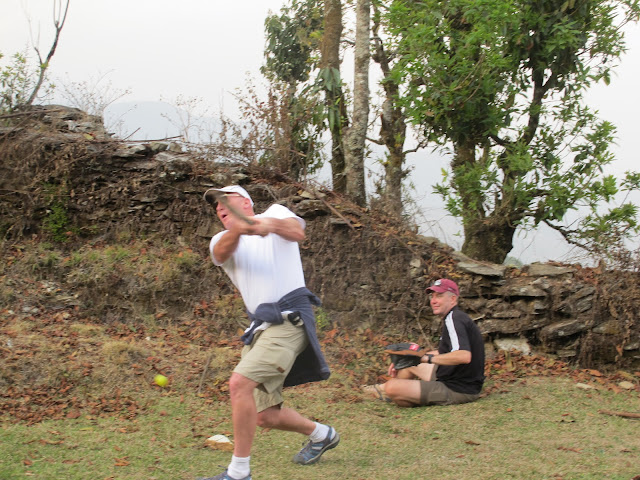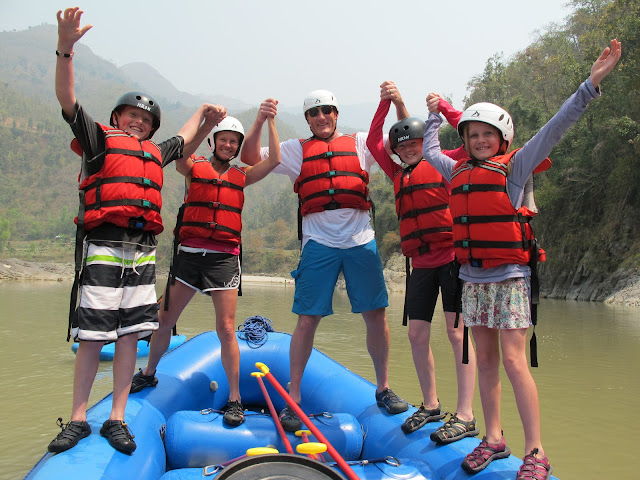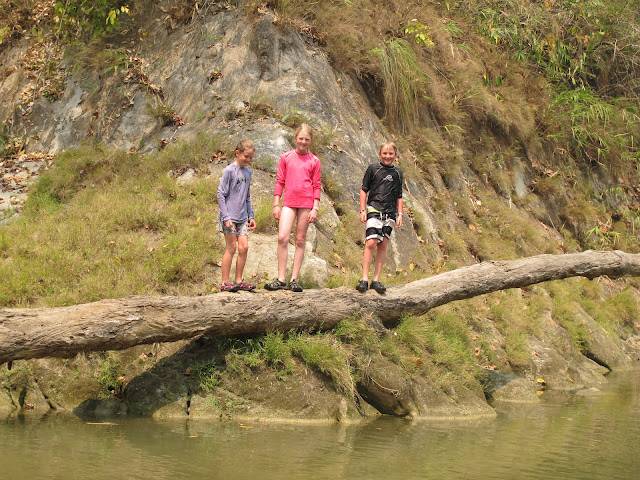Ah to escape the filth of India in exchange for the pristine
Himalayas! Such were our
expectations. We arrived in Kathmandu,
somewhat expecting relief from India, and discovered that the differences were
indiscernible. I had somewhere read that
Kathmandu was a relatively small town. Maybe
that was 50 years ago. At 5 million or
so (and I wouldn’t trust any Indian or Nepalese census) I guess it is small
compared to Delhi. Being somewhat wily
veterans of navigating the streets of India, we ventured out from our Kathmandu
hotel and found a lovely restaurant and did some smart shopping and vicious
bargaining at some local shops. Then it
was off to pack for our 4 day trek.
The morning before starting our trek, we decided to take a mountain
flight on Air Buddha to see Mt. Everest.
Billed as “the greatest Mt. flight in the world” it was a huge
letdown. We had to awaken the kids at
5:20, missed any semblance of a decent breakfast (or the all important cup of
coffee), waited at the airport for an hour or so prior to departure, then once
airborne had a few brief sneak peeks through frosty and scratched windows at
Mt. Everest from about 75 miles away.
Lame, lame, and made more lame by the stewardess selling “I didn’t climb
it but I really saw it and loved it” t-shirts as we descended through the smog
back to Kathmandu. She actually sold a
few which was a sad commentary on our fellow passengers.
But enough of the glass half-empty, now to the trek. We boarded another flight several hours after
the scenic letdown to Pokhara, about 200km NW of Kathmandu. Our trek was called the “Prince’s Trek”, so
named for a relatively easy, low-altitude route developed for Prince Charles in
the early 1980’s. After gathering our gear, we were met by our guide and
escorted to our van. It was something
straight out of the Beverly Hillbillies, with the van wobbling with a tower of
reed baskets and gear on the top.
Sitting in the back two rows of the van was a group of Nepalese that I
assumed was two families that were in need of a lift. I was happy that our tour operator was making
use of some of the extra room in the van and doing a good deed. We drove about 30 minutes to the outskirts of
town and stopped at the bottom of a steep trail. To my surprise the “families” in the back of
the van were our support crew. I felt
like an idiot, but was quickly consoled by the realization that it wasn’t the
first timeJ! Our family of 5 was accompanied by a support
crew of count ‘em 12, yes 12 people. We
had our main guide, called a Sirdar. We
then had 1 cook, 3 sherpas, 3 cook boys, and 5 porters. This is pretty much the class hierarchy of the
crew, based on experience and to some unknown degree, social class. Our Sirdar, named Ang Pemba, was a beautiful
man who I’m guessing was about 55 but could have been 40 or 70. He had summited Everest once and been just
below the summit in a supporting role several other times. He
took great care of us but unfortunately we don’t speak Nepalese and his English
was not that much better than that of the school teacher in the Charlie Brown tv
shows. We hiked 3-5 hours a day at
elevations ranging from 3-7000’, and camped in some beautiful spots: the first
being beyond a village called Bhumdi, the second called President’s camp
just below Panchese Lekh, and the third
called Tashi’s camp above the village of Bhadhaure. The kids were strong and didn’t complain. It was great for all to get some serious
exercise for the first time in almost 3 weeks.
I’m guessing we hiked about 5 miles and gained about 2-3000’ in altitude
each day. Despite the size of the
entourage, our accommodations and were pretty basic which was an appreciated
change; much like the camping we occasionally enjoy in Idaho. It was great to work hard, enjoy a campfire meal,
go to bed at 8 and awaken before 6.
Several mornings we were treated to beautiful views of the
mountains. We were super close to the
Annapurna range and some huge peaks (two over 8,000 meters) but unfortunately
there was so much smoke and smog that the hoped for views were obscured to
varying degrees. Two mornings we could
see the peaks, especially the spectacular Annapurna South and Macchapuchre, but
not to the sparkling degree that we had hoped.
It was obvious that the peaks were spectacular, but when we looked at
pictures of what is seen when it was clear, we were left with mouths
agape. Still the exercise, the camping,
the friendly Nepalese, and the relatively clean air (in contrast to India and
Kathmandu) provided an incredibly positive experience for each of us. As an added benefit, we met 3 American
families with similarly aged kids who were on the same basic trek. These folks were all living in Singapore, and
it was delightful to share the late afternoons at two of the campsites with
them.
After 4 days of trekking, we stayed at a cool hotel just outside of
Pokhara called the Pokahara Mountain Lodge.
Built on top of a local mountain by a Briton who pretty much pioneered
the trekking business in Nepal, it had amazing views, nice clean rooms, a
swimming pool, and most importantly great showers. It was great to take a LONG warm shower and
to soak (i.e. throw Hayden in backflips) in the pool. In the morning, the skies were relatively
clear and there was an amazing vista of Annapurna South (7219m), Annapurna I
(8091m), Machhapuchre (6993m), Annapurna III (7555m), Annapurna IV (7525m) and
Annapurna II (7937m).
Our two main objectives for Nepal were to trek and to jungle safari in
hopes of seeing the elusive Bengal Tiger.
With a successful trek under our belts, we headed south out of the mountains
to jungle territory on the southern border with India. A 5 hour drive, we decided to break it up
with some river rafting. Our guide,
Santosh, was a beauty. He was about 35
but was really just a big kid. After a
very detailed and professional safety briefing (which turned out to be
unnecessary), we were off into mostly gentle rapids. There were a few sections of the river that
got the heart pounding, but the raft was so big and well-built that it handled
everything with ease. What we will
remember is Santosh playing “Titanic” with each of us (suspending us from the
side of the raft with a rope), having us stand on the edges and paddle, having
us stack together on the front of the boat as went through rapids, and really
engaging with the kids and making it a blast for all of us. We took several plunges in the river which
was super refreshing, as long as we didn’t think too much about its
astronomical bacterial levels and assumed the brown color was from sediment.
After rafting we were subject to a 3 hour bone jarring drive south to
Royal Chitwan National Park and to Tiger Tree Tops Tented Camp. This camp has pretty basic (but large)
sleeping tents with attached bathrooms/showers.
Nothing like the sheik accommodations in or many safari camps in Africa,
but relatively posh compared to our earlier trek. Our small camp was truly an oasis from the
press of humanity, and if it weren’t for the threat of scorpions or the 4”
spiders in our bathroom, it would have been idyllic. Our days were spent with a variety of
wildlife viewing activities: walking
tours, jeep safaris, boat/river safaris, and elephant safaris. Our first day here was Halle’s 9th
birthday, March 31. We started with an
elephant safari, and from the backs of the magnificent beasts we saw dozens of
Rhinoceros, deer, wild boar, and hundreds of birds. Halle then enjoyed some “mommy time” with
Traci in our tent (reading of course) while Hayden, Sydney and I did a local
walk. After a lunch of meatballs
(Halle’s favorite….I think she ate about 20), we were off to learn more about
elephants. After
about a 20 minute presentation on elephants, we were off to the river to help
bathe them. The elephants know about 25
verbal commands, and being a quick study and master dog trainer, I realized
that these included (in Nepalese) “sit” “kneel” “lay down on the left side”
“lay down on the right side” and “get up”.
The birthday girl quickly accepted an offer to ride an elephant in the
river, and quickly learned that this elephant knew another command which was
“shower the rider on your back with a trunk-full of water”. The elephant shower was a huge hit. Next up was a late afternoon jeep safari in
search of the elusive tiger. Alas the
tiger was not to be seen but we still saw some amazing wildlife. Following a delicious dinner and special
chocolate birthday cake, we retreated to our tent where I had just enough
battery power left in my computer for snuggling together to watch one of
Halle’s favorite movies, “Momma Mia”.
Hayden chose to go to bed as he accurately described the movie as “It is
so dumb…all that happens is that people get sad and then they start singing
songs”. Great day for Halle and
all.
We realized that our chances at seeing a tiger were very slim. The odds are as good here in Nepal as at any
of the reserves in India such as Rathambore (and those odds are still
long). The guides tried to be optimistic
but in reading the guestbook we sadly noted that a tiger hadn’t been seen in
about a month. There are only 7 of them
that cover a relatively vast area around the camp and most of the reserve is
covered with thick, 10’ high striped black and orange grasses (kinda tiger
like!) that make viewing anywhere other than on a road impossible. We spent our last safari drive with a Danish
pilot from Hong Kong and his two kids.
We searched hard, to no avail, including hiking up and sitting in a
watch tower. On the way back to the
camp, Sydney and I were discussing if we could arrange an early morning jeep
safari to give us one more chance to see a tiger, when lo and behold, what
should appear on the road ahead of us but a huge male tiger. Named “Rhino Hunter”, this big fellow quickly
disappeared into the bush, then reappeared on the road about 25 yards behind us
and walked casually along, stopping every 10 yards or so to mark his
territory. We were stunned. Our driver and guide were high fiving and very
excited, which told me that what we just witnessed was pretty rare. Once again the good Janssen fortune came
through.
Nepal has been a fascinating country to visit. Like India it is definitely third world, but
the people seem a bit more innocent and happier.
I still find it striking how much pollution, filth, and garbage there
is. We were rafting down a beautiful
river gorge. One minute you are
marveling at incredible geologic rock formations (vast layers that are twisted
in a “U” shape) and waterfalls, then the next moment you see a landslide of
plastic garbage bags that are carelessly and very purposefully chucked off the
road and down towards the river. Someone
(I’m assuming it’s a government official) then sets these on fire and that is
their idea of a landfill. Both here and
in India I tried SO HARD to see the logic in how things were done, yet could
never see it in anything. Roads and
traffic are deplorable. There is no
thought given to traffic control or separation of different types of
vehicles. People stop their cars or
trucks on the side of the road without the tiniest bit of consideration of what
that will do for other vehicles and traffic disruption. Why don’t they attempt to have slower
vehicles travel on the left (traffic is left-handed aka British here). Why don’t they at least dig a big pit for
their refuse and if they have to burn it, do it there or at a minimum bury it? If developing rafting on the river is
important, isn’t keeping it clean a requirement? On our trek hiking, there was plastic trash
scattered at all elevations (although it was less the higher we went). Why don’t the trekking outfits have their
people make an effort to help clean this up and leave the trail better than
they found it? The people here are
averse to killing many types of animals (our lead guide on our trek was
insistent that we not burn kindling in our campfire that had a few lady bugs on
it), yet they take no notice of the piles of plastic that are clogging their
trails, roads, streams and rivers and oceans.
Traveling in this part of the world makes you quickly realize the
importance of recycling plastics. The bottom line in this area is that the crush
of humanity is relentless, and along with that comes a devaluation of
life. Humans have an incredible will and
ability to survive, to the detriment of other creatures and habitat. With government corruption so rife, the
education required to break this poverty will likely never happen.
 |





.JPG)

.JPG)




.JPG)
.JPG)




.JPG)

.JPG)














.JPG)










No comments:
Post a Comment